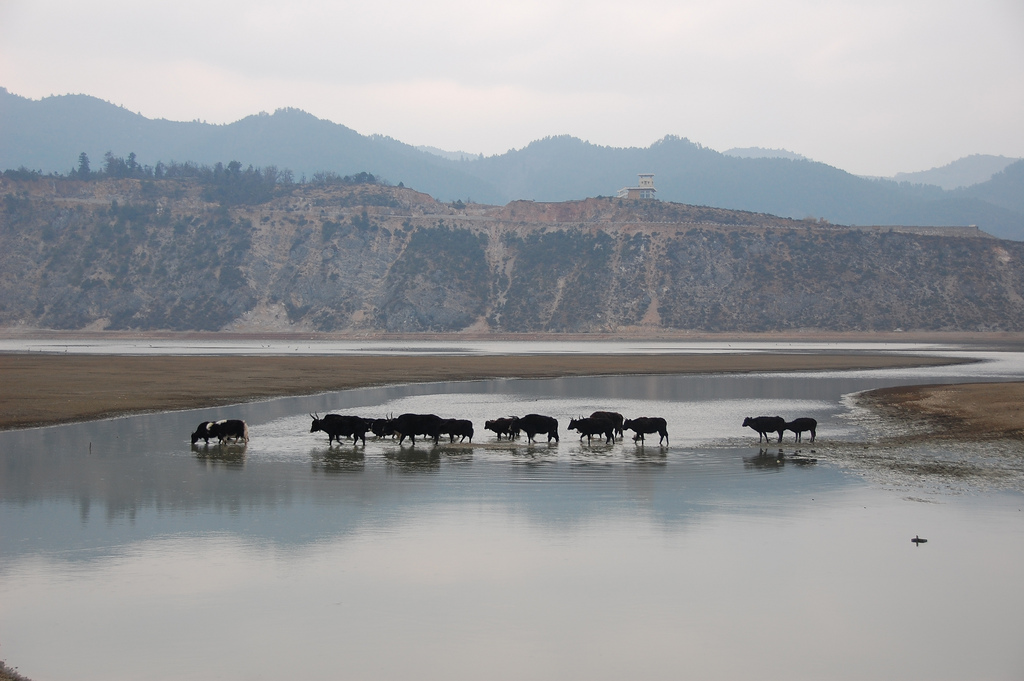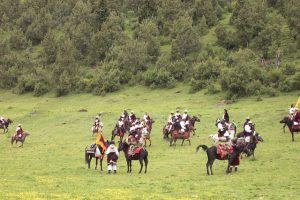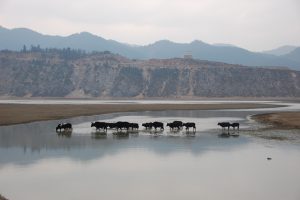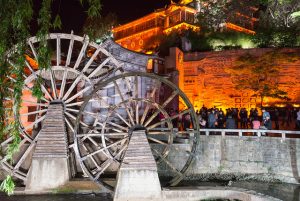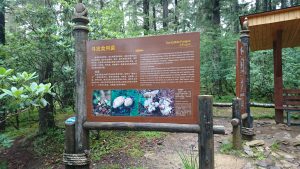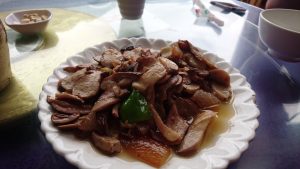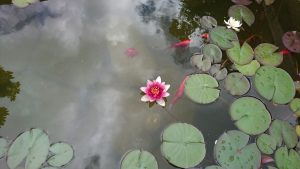Monique Segarra, Assistant Professor Bard Center for Environmental Policy
With the generous support of the Luce Foundation Asia and the Environment grant to Bard College, I spent two weeks this July in Yunnan Province, located in Southwestern China. Traveling with my colleague, Dr. Bruce Robertson, we designed a trip that reflected our respective interests in conservation and natural resource management. As a political scientist, I study the socio-economic impacts of conservation models—for instance, the creation of national parks and protected areas—on surrounding communities that are often poor and indigenous in Latin America and in sub-Saharan Africa. Recently, I have started work on global agricultural commodity chains that link smallholder producers to global markets. Dr. Robertson’s expertise as a conservation biologist enabled us to work as an inter-disciplinary team as we interviewed academics and non-governmental actors about China’s push towards ‘ecological modernization’ in Yunnan Province, through the expansion of national parks and eco-tourism. In addition, we studied the scientific and socio-economic factors that surround the booming wild mushroom trade between Yunnan and Japan. The interviews and site visits we conducted provided cases and teaching materials that I am using in my current seminar on global food politics and in my fall and spring graduate courses on environmental and climate policy.
We selected Yunnan for a number of reasons. It is one of the most biodiverse provinces in China and crucial to the watershed of three major rivers, the Yangtze, Mekong and the Salween. Recognized by UNESCO as a World Heritage Site and recently targeted by China’s central government as an environmentally sensitive province, there is nonetheless extensive mining, agricultural and industrial activity that continues to pose a significant threat to both the environment and to human health. In addition to being a biodiversity hot spot, Yunnan is culturally diverse, with over 50 ethnic minorities and a large Tibetan community. The province borders the Tibetan Autonomous Region and historically served as a central link in the ancient Tea Horse Road, trading tea and Tibetan horses west into India and east to Central China. Since the 2000s, the central government has strategically utilized the imagery of the ancient Tea Horse Road to promote economic development through tourism but also to link Yunnan to its Southeast Asian neighbor states through increased regional trade in oil and natural gas. We found examples of the tensions inherent in balancing the push for economic development with policy goals for environmental and cultural sustainability at each stage of our two week journey.
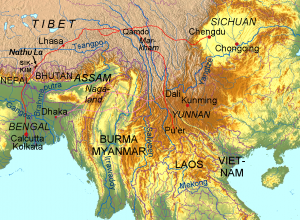
Yunnan’s cultural and biodiversity is similar to areas where I work in Latin America, including Oaxaca where Bard CEP has a long running collaboration with NGOs, academics and indigenous communities around water management and biodiversity conservation. But the deciding factor for me in selecting Yunnan was my experience in working with two CEP graduate students. Both students are ethnic Tibetans, and each worked on different aspects of Chinese policies regarding the grasslands of Tibet and how those policies have impacted the nomadic practices of Tibetans and consequently, how they manage their herds of Yaks. The truth is I went to Yunnan to see a Yak, up close and in its natural setting.
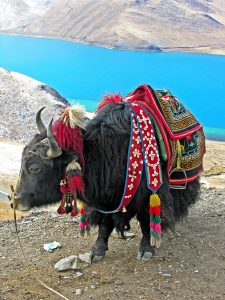
Kunming
The starting point of our research in Yunnan was the provincial capital of Kunming, called the ‘Spring City’ because of its altitude, which is over 6,000 feet, and its year round temperate climate. I realized as we landed that there is no small city in China. With over six million people (roughly the size of Dallas, Texas) and growing, the city is reinventing itself as a trade and transportation hub linking Yunnan to neighboring Laos, Vietnam and Myanmar though a network of roads, trains and oil and gas pipelines. This expansion is due to the national government’s plan to jumpstart the province’s economic growth, one of the poorest in China, and to capitalize on the potential for regional integration. The central government’s goals for energy production and energy security by bringing oil from Myanmar, however, quickly met with local community resistance. Environmental NGOs questioned the siting of the oil refinery and a new petro-chemical plant in Annan, just west of Kunming. Urban and rural communities mobilized against the project, concerned over increased pollution and potential toxic exposure. Despite significant street protests in 2014, NGOs and citizens were not able to block the projects.
In the wake of this, and other failures to pursue companies and the government for pollution cleanup, a key lesson learned for some NGOs was to shift tactics. Rather than pursue classic activism, one strategy is to assist communities and other NGOs in navigating the dense and technical language of Environment Impact Statements (EIS). China has an extensive environmental legal structure, but the implementation of environmental regulations has been relatively weak. Through networking and knowledge sharing, environmental NGOs identify leverage points where local communities can engage with the state and developers in a more informed fashion by making make the EIS process less opaque. We found this theme of strategic navigation vis-à-vis local, provincial and national authorities repeated across our interviews. The nature of the China’s state system combined with economic policies that privilege industry (much of which is state owned) creates barriers but also opportunities for NGOs to intersect with the multiple levels of state authorities, from local governments to national agencies. As policy directives from above shift over time, in some cases NGOs respond to the changing demands on lower levels of state actors by presenting themselves as capacity builders. We encountered this capacity enhancing role when we met with NGOs in Shangri-La. By presenting themselves as technical partners in environment education, sustainable livelihoods and community training, NGOs move into a more politically neutral space, thereby avoiding tensions with the government that, depending on shifts in policy, leadership or political events, could perceive NGOs as either supplanting government programs or working to support opposition to the state.
While in Kunming we met with academics from Yunnan University and the Kunming Institute of Botany, World Agroforestry Center. At the graduate Institute of Ecology and Geobotany Yunnan University, the scientists and graduate students were generous with their time, giving us an overview of the social ecology of Upper Yunnan, as well as their respective research interests. Several of the professors were deeply involved in the developing the adaptive management plans for Potatso National Park, which we later visited (read more about Professor Robertson’s visit), They hosted us for an incredible lunch of local specialties at the University’s faculty club, providing us with our first experience of the important role of food in Chinese culture. For the Chinese, hospitality means ordering or cooking more dishes than a guest could be expected to eat. Food waste, therefore, is built into the culture. For those of us coming from a clean plate club, this caused some initial confusion over how much we were expected to eat in order not to offend our hosts, as well as a slight sense of panic when invited to lunch or dinner.
Tourism in Lijiang and Shangri-La
Our next stop was the old town of Lijiang. For over 800 years, the town has been dominated by the Naxi minority people. The Naxi are well known for the persistence of their cultural traditions, which include a matrilineal family structure. Their culture plus the maintenance of the old city buildings, bridges and canal system, enabled Lijiang to be classified as a World Heritage Site in 1997. Once a popular destination primarily for adventurous international backpackers, the state targeted Lijiang for heritage tourism development during the 2000s. In the process of ‘modernization’ and in order to attract mainstream international and domestic tourists, the ancient town was rapidly transformed from residential Naxi neighborhoods, to shops, restaurants and hotels. This effort was successful, and the state tourism board notes that the number of annual visitors can top 5 million, the majority of which are domestic Chinese. Although the guest house where we stayed is owned by a Naxi woman, the economic gains from tourism are unevenly spread across the Naxi, Tibetans and Han Chinese. While much of the allure of tourism from Lijiang to Shangri-La is based on cultural heritage and natural beauty, it is not eco-tourism as I think of it. We were there in July, a peak month for travel in this region, and the old town was surrounded by modern parking lots full of tour buses. The town has a strong feeling of Disneyfication, with local Naxi and Lisu minority people in traditional dress performing in the town squares and posing for pictures with tourists. Observing this dynamic left me with a strong interest in knowing more about how the intersection of local, national and international stakeholders’ visions of what constitutes heritage tourism is impacting cultural and environmental conservation in Lijiang.
From Lijiang, we followed the tourist route by car to Zhondian, aka Shangri-La. We deviated from what I think of as the Yunnan ‘check list’ sites by skipping Tiger Leaping Gorge and the upper slopes of Jade Dragon Snow Mountain. We stopped instead to view the Yangtze River, which even at the upper reaches of the watershed was turbid and heavily polluted. Once home to the baiji, a river dolphin found only in the Yangtze, a combination of dams, increased shipping traffic and pollution caused the extinction of this species by 2006. Once past the river, the road began to twist and climb, and Yaks as well as Buddhist markers (stupas) with prayer flags dotted the fields as we neared Shangri-La, located at 10,000 feet.
Shangri-La
In 2001, the national government renamed Zhondian as Shangri-La, capitalizing on the Western cultural motif around James Hilton’s novel, Lost Horizon. The renaming symbolizes the state’s ambitions to consolidate the tourism route for Northern Yunnan. Zhondian was selected for several reasons. It had an old town similar to Lijiang, it is proximate to Potatso (China’s first national park), Jade Dragon Snow Mountain and a Ramseur-designated wetlands, Napahai Lake, home to the rare black neck crane. In addition, on the outskirts of the city is the Songzanlin monastery, one of the largest Buddhist temples outside of Lhasa, Tibet.
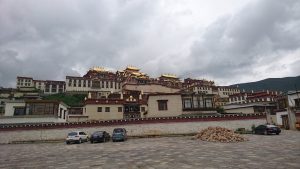 Within miles of the city, there are multiple parks and protected areas, and we visited Potatso (Paduco) National Park. The park is breathtaking, with high altitude lakes, meadows and alpine forests. In addition to the natural beauty, my interest in the park was around the issue of enforcement. It is a problem that, depending on whose perspective, either (1) prevents local peoples from using the natural resources of newly created protected areas and national parks, or (2) whose lack undermines the natural resource conservation goals of scientists and environmental managers. We found outcomes in Yunnan that surprised me. I had assumed that because of the power of the state, the boundaries and management of the parks/protected areas would be top down and that local communities would have little power or ability to benefit from the accelerating pace of conservation driven by the new model of ‘ecological modernization.’ Yet we found mixed outcomes. In the well-documented case of Potatso National Park, local Tibetan communities were allowed to continue to use the traditional summer pastures that form the alpine meadows of the park as well as graze horses and pigs in areas near the road or the walking platforms. In addition, summer grazing shelters near these areas are used by the local community. This form of compromise is often considered to be counterproductive by conservation specialists in that it can lead to ecosystem degradation, but the decision was perceived as a more equitable and pragmatic choice by park managers.
Within miles of the city, there are multiple parks and protected areas, and we visited Potatso (Paduco) National Park. The park is breathtaking, with high altitude lakes, meadows and alpine forests. In addition to the natural beauty, my interest in the park was around the issue of enforcement. It is a problem that, depending on whose perspective, either (1) prevents local peoples from using the natural resources of newly created protected areas and national parks, or (2) whose lack undermines the natural resource conservation goals of scientists and environmental managers. We found outcomes in Yunnan that surprised me. I had assumed that because of the power of the state, the boundaries and management of the parks/protected areas would be top down and that local communities would have little power or ability to benefit from the accelerating pace of conservation driven by the new model of ‘ecological modernization.’ Yet we found mixed outcomes. In the well-documented case of Potatso National Park, local Tibetan communities were allowed to continue to use the traditional summer pastures that form the alpine meadows of the park as well as graze horses and pigs in areas near the road or the walking platforms. In addition, summer grazing shelters near these areas are used by the local community. This form of compromise is often considered to be counterproductive by conservation specialists in that it can lead to ecosystem degradation, but the decision was perceived as a more equitable and pragmatic choice by park managers.
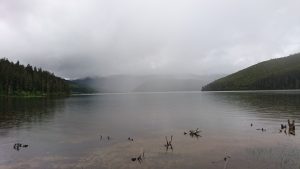
In contrast to the managed use of the Potatso Park, our visits in Lijiang to the Wenbi Mountain Protected Area and to the Napahai Lake near Shangri-La, provided us with cases where individual and community uses of natural resources were more fluid. Driving from the city to Napahai Lake, we observed examples of what is termed ‘undisciplined tourism’-the siting of hotels, restaurants and pony rides, a major form of economic gain for the Tibetan population from tourism-randomly dotting the shores of the lake and the seasonal meadows that appear during the summer when the lake shrinks in size. This is leading to serious environmental degradation of the land and increased water pollution due to increased usage and sewage. In our visit to the Wenbi Mountain Protected Area outside of Lijiang, we observed local farmers and town dwellers parking on the side of the road and walking into the forests to harvest buckets of wild mushrooms. Despite the beauty of Wenbi Mountain, with its lush forests and remarkable scenery crowned by the 18th century Wenfeng Temple, it was surprisingly devoid of visitors. Although a relief after the overcrowded streets of Lijiang Old Town, aside from the periodic signage, there was no visible oversight of the park or constraints on the harvesting of non-timber forest products.
Our trip coincided with the wild mushroom season that includes the matsutake mushroom (‘pine cone’ in Japanese) that has become one of the lead agricultural exports for Yunnan, generating up to 17 million US dollars per annum. In Kunming, we discussed the socio-economic and environmental impacts of this escalating trade with Kunming Institute of Botany staff and learned about the tensions that it is causing in some communities, where wild mushroom foragers can earn up to the equivalent of 6,000 US dollars during the three-month season. Since the 1997 logging ban in northern Yunnan put in place by the national government to protect the watershed, non-timber forest products such as wild mushrooms have replaced timber as a lead non-farm income for rural families. In Shangri-La we were able to visit the local markets and watch the beginning of a commodity chain that stretches from northern Yunnan to Japan. We observed as Tibetan and other ethnic minority women brought baskets of matsutake mushrooms and negotiated with market buyers, also women, who then sell to a consolidator whose trucks are waiting to take the matsutake to the airport where it is flown out to Japan within 48 hours. One of the key concerns, in addition to potential overharvesting and forest degradation, is the inequality built into the commodity chain, with mushroom pickers and lower-level traders receiving relatively low prices, as profits are concentrated further up the chain in the hands of larger market buyers and shipping companies.
The two weeks in Yunnan have enabled me to develop a rich set of teaching materials for my classes. They showed me as well, however, that there is much about Chinese politics and culture that I do not understand. As a comparative political scientist I have read and taught about the nature of the state and the political regime in China, a model described in my field as fragmented authoritarianism. This means that policy decisions made at the central government become open for negotiation within implementing agencies and at descending levels of government. This creates a model of both strong national power and leadership combined with a complex web of bargaining, as those national directives are shaped to fit local politics and economic interests. For an outsider, this makes following the thread of struggles over pollution control and various forms of natural resource management among state and non-state actors extremely difficult to unravel.
Yet in the end, China intrigued and bewitched me. The night before my return flight to New York I found myself in front of the North Railway Station in Beijing. It was brightly lit and bustling with activity, and as I listened to the announcements for trains sending people north and west from Outer Mongolia to Tibet, through Central Asia to Russia, I experienced an overwhelming desire to board a train and continue my journey. This trip, combined with the experiences and lessons I learned last summer in two LIASE-sponsored trips to South Korea and Hong Kong, has given me a wider lens through which to see how different cultures and countries address similar types of environmental problems. The journey to Yunnan has inspired me to think about future projects focusing on the comparative dynamic of conservation enforcement, the impact of tourism on local cultures and the environment, and how global demand for non-timber forest products such as mushrooms impacts the smallholder communities who source the commodity and the supply chains that link people, often in remote areas, with consumers in Asia and the United States. Finally, I look forward to developing and deepening the intellectual ties and new friendships we developed in Yunnan and to strengthening the institutional connections between those groups, Bard College and Bard CEP.

